Myocardial Infarction Case Study: Nursing Assessment and Interventions
VerifiedAdded on 2020/03/16
|13
|3603
|128
Case Study
AI Summary
This case study focuses on a 52-year-old male, Mr. Jack, who presented to the emergency department with a myocardial infarction (MI). The assignment provides a comprehensive analysis of the patient's condition, including his medical history of diabetes mellitus, smoking, and alcohol use, and the presenting symptoms of chest pain, radiating pain, and other vital sign abnormalities. It delves into the clinical priorities, such as pain management and activity intolerance, and outlines detailed nursing interventions including pain control, anxiety reduction, activity promotion, and measures to prevent decreased cardiac output. The study emphasizes the importance of monitoring vital signs, providing patient education, and implementing collaborative care with a multidisciplinary team, including cardiologists, and other specialists. Furthermore, the case study highlights the significance of following established guidelines, such as ACCF/AHA/SCAI, in the management of MI and the critical role of nursing in the overall care and management of patients experiencing this life-threatening condition.

Running head: BACHELOR NURSING ASSIGNMENT
Bachelor nursing assignment
Name of the Student
Name of the University
Author note
Bachelor nursing assignment
Name of the Student
Name of the University
Author note
Paraphrase This Document
Need a fresh take? Get an instant paraphrase of this document with our AI Paraphraser
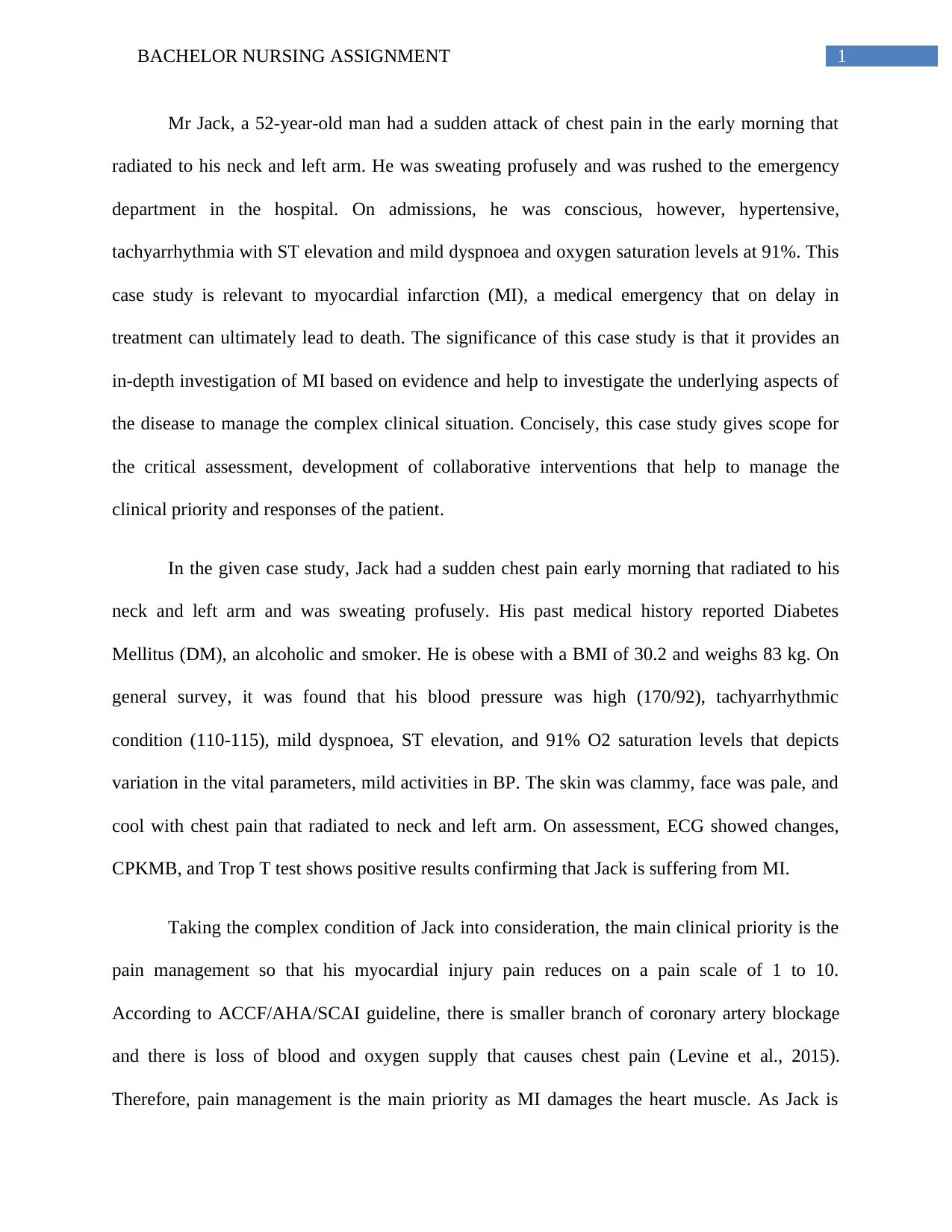
1BACHELOR NURSING ASSIGNMENT
Mr Jack, a 52-year-old man had a sudden attack of chest pain in the early morning that
radiated to his neck and left arm. He was sweating profusely and was rushed to the emergency
department in the hospital. On admissions, he was conscious, however, hypertensive,
tachyarrhythmia with ST elevation and mild dyspnoea and oxygen saturation levels at 91%. This
case study is relevant to myocardial infarction (MI), a medical emergency that on delay in
treatment can ultimately lead to death. The significance of this case study is that it provides an
in-depth investigation of MI based on evidence and help to investigate the underlying aspects of
the disease to manage the complex clinical situation. Concisely, this case study gives scope for
the critical assessment, development of collaborative interventions that help to manage the
clinical priority and responses of the patient.
In the given case study, Jack had a sudden chest pain early morning that radiated to his
neck and left arm and was sweating profusely. His past medical history reported Diabetes
Mellitus (DM), an alcoholic and smoker. He is obese with a BMI of 30.2 and weighs 83 kg. On
general survey, it was found that his blood pressure was high (170/92), tachyarrhythmic
condition (110-115), mild dyspnoea, ST elevation, and 91% O2 saturation levels that depicts
variation in the vital parameters, mild activities in BP. The skin was clammy, face was pale, and
cool with chest pain that radiated to neck and left arm. On assessment, ECG showed changes,
CPKMB, and Trop T test shows positive results confirming that Jack is suffering from MI.
Taking the complex condition of Jack into consideration, the main clinical priority is the
pain management so that his myocardial injury pain reduces on a pain scale of 1 to 10.
According to ACCF/AHA/SCAI guideline, there is smaller branch of coronary artery blockage
and there is loss of blood and oxygen supply that causes chest pain (Levine et al., 2015).
Therefore, pain management is the main priority as MI damages the heart muscle. As Jack is
Mr Jack, a 52-year-old man had a sudden attack of chest pain in the early morning that
radiated to his neck and left arm. He was sweating profusely and was rushed to the emergency
department in the hospital. On admissions, he was conscious, however, hypertensive,
tachyarrhythmia with ST elevation and mild dyspnoea and oxygen saturation levels at 91%. This
case study is relevant to myocardial infarction (MI), a medical emergency that on delay in
treatment can ultimately lead to death. The significance of this case study is that it provides an
in-depth investigation of MI based on evidence and help to investigate the underlying aspects of
the disease to manage the complex clinical situation. Concisely, this case study gives scope for
the critical assessment, development of collaborative interventions that help to manage the
clinical priority and responses of the patient.
In the given case study, Jack had a sudden chest pain early morning that radiated to his
neck and left arm and was sweating profusely. His past medical history reported Diabetes
Mellitus (DM), an alcoholic and smoker. He is obese with a BMI of 30.2 and weighs 83 kg. On
general survey, it was found that his blood pressure was high (170/92), tachyarrhythmic
condition (110-115), mild dyspnoea, ST elevation, and 91% O2 saturation levels that depicts
variation in the vital parameters, mild activities in BP. The skin was clammy, face was pale, and
cool with chest pain that radiated to neck and left arm. On assessment, ECG showed changes,
CPKMB, and Trop T test shows positive results confirming that Jack is suffering from MI.
Taking the complex condition of Jack into consideration, the main clinical priority is the
pain management so that his myocardial injury pain reduces on a pain scale of 1 to 10.
According to ACCF/AHA/SCAI guideline, there is smaller branch of coronary artery blockage
and there is loss of blood and oxygen supply that causes chest pain (Levine et al., 2015).
Therefore, pain management is the main priority as MI damages the heart muscle. As Jack is
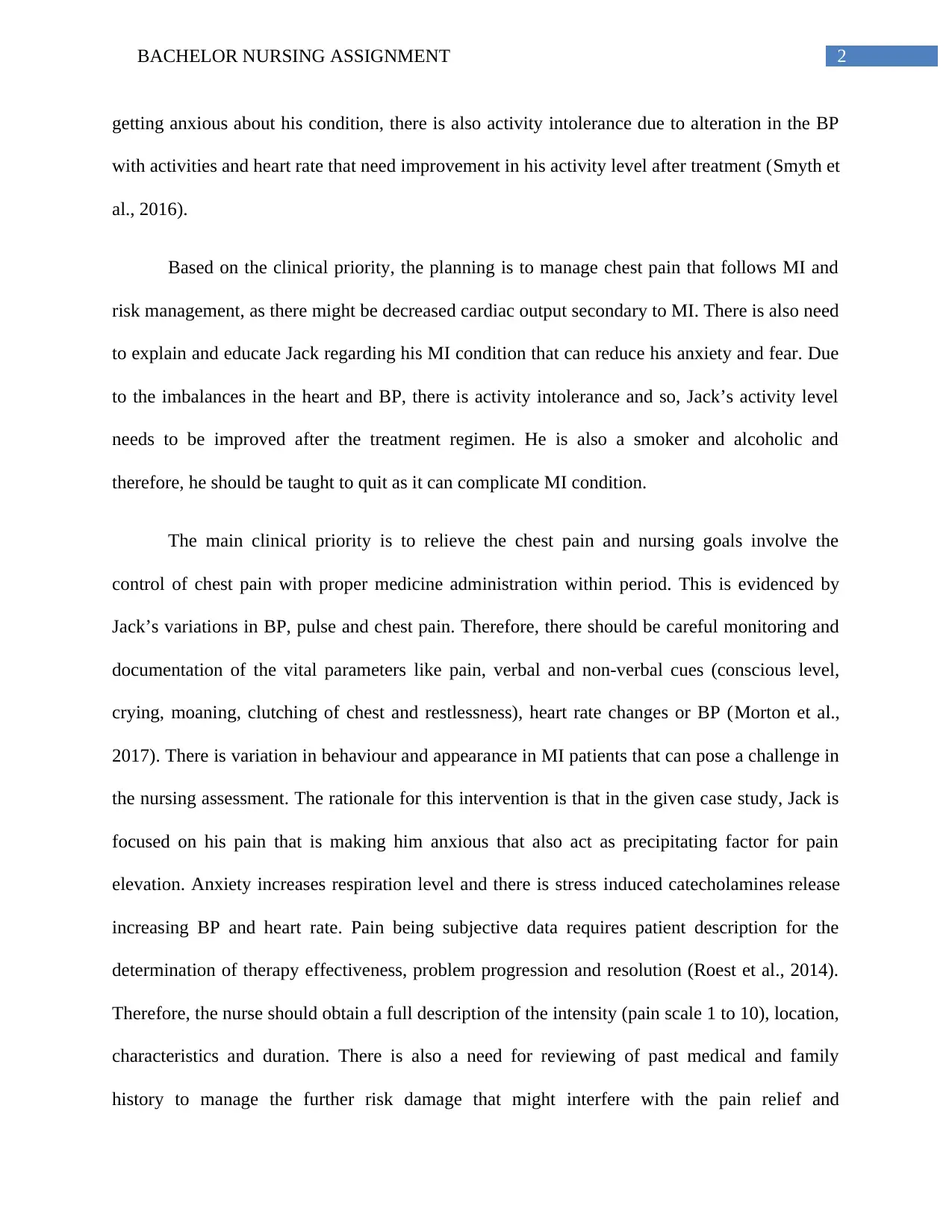
2BACHELOR NURSING ASSIGNMENT
getting anxious about his condition, there is also activity intolerance due to alteration in the BP
with activities and heart rate that need improvement in his activity level after treatment (Smyth et
al., 2016).
Based on the clinical priority, the planning is to manage chest pain that follows MI and
risk management, as there might be decreased cardiac output secondary to MI. There is also need
to explain and educate Jack regarding his MI condition that can reduce his anxiety and fear. Due
to the imbalances in the heart and BP, there is activity intolerance and so, Jack’s activity level
needs to be improved after the treatment regimen. He is also a smoker and alcoholic and
therefore, he should be taught to quit as it can complicate MI condition.
The main clinical priority is to relieve the chest pain and nursing goals involve the
control of chest pain with proper medicine administration within period. This is evidenced by
Jack’s variations in BP, pulse and chest pain. Therefore, there should be careful monitoring and
documentation of the vital parameters like pain, verbal and non-verbal cues (conscious level,
crying, moaning, clutching of chest and restlessness), heart rate changes or BP (Morton et al.,
2017). There is variation in behaviour and appearance in MI patients that can pose a challenge in
the nursing assessment. The rationale for this intervention is that in the given case study, Jack is
focused on his pain that is making him anxious that also act as precipitating factor for pain
elevation. Anxiety increases respiration level and there is stress induced catecholamines release
increasing BP and heart rate. Pain being subjective data requires patient description for the
determination of therapy effectiveness, problem progression and resolution (Roest et al., 2014).
Therefore, the nurse should obtain a full description of the intensity (pain scale 1 to 10), location,
characteristics and duration. There is also a need for reviewing of past medical and family
history to manage the further risk damage that might interfere with the pain relief and
getting anxious about his condition, there is also activity intolerance due to alteration in the BP
with activities and heart rate that need improvement in his activity level after treatment (Smyth et
al., 2016).
Based on the clinical priority, the planning is to manage chest pain that follows MI and
risk management, as there might be decreased cardiac output secondary to MI. There is also need
to explain and educate Jack regarding his MI condition that can reduce his anxiety and fear. Due
to the imbalances in the heart and BP, there is activity intolerance and so, Jack’s activity level
needs to be improved after the treatment regimen. He is also a smoker and alcoholic and
therefore, he should be taught to quit as it can complicate MI condition.
The main clinical priority is to relieve the chest pain and nursing goals involve the
control of chest pain with proper medicine administration within period. This is evidenced by
Jack’s variations in BP, pulse and chest pain. Therefore, there should be careful monitoring and
documentation of the vital parameters like pain, verbal and non-verbal cues (conscious level,
crying, moaning, clutching of chest and restlessness), heart rate changes or BP (Morton et al.,
2017). There is variation in behaviour and appearance in MI patients that can pose a challenge in
the nursing assessment. The rationale for this intervention is that in the given case study, Jack is
focused on his pain that is making him anxious that also act as precipitating factor for pain
elevation. Anxiety increases respiration level and there is stress induced catecholamines release
increasing BP and heart rate. Pain being subjective data requires patient description for the
determination of therapy effectiveness, problem progression and resolution (Roest et al., 2014).
Therefore, the nurse should obtain a full description of the intensity (pain scale 1 to 10), location,
characteristics and duration. There is also a need for reviewing of past medical and family
history to manage the further risk damage that might interfere with the pain relief and
⊘ This is a preview!⊘
Do you want full access?
Subscribe today to unlock all pages.

Trusted by 1+ million students worldwide
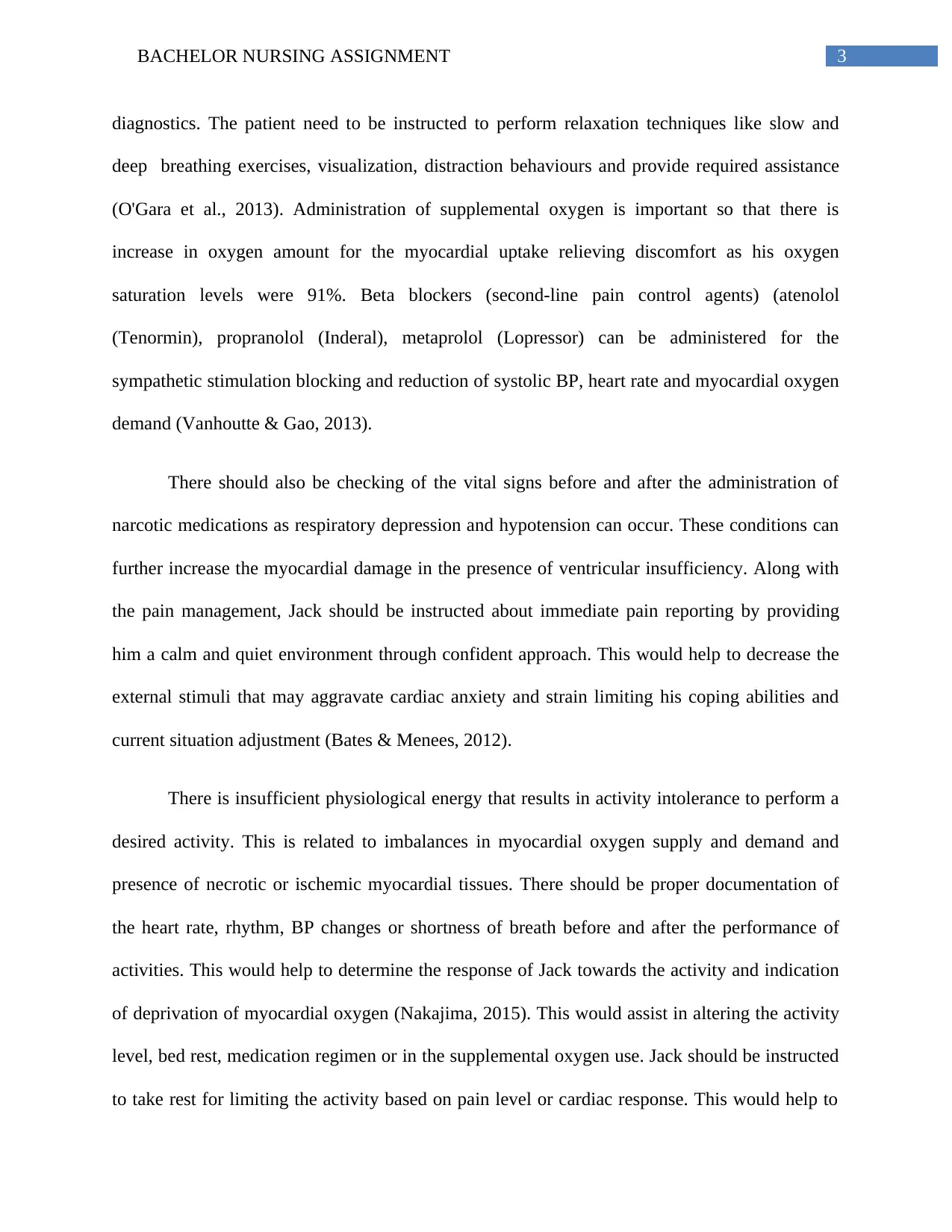
3BACHELOR NURSING ASSIGNMENT
diagnostics. The patient need to be instructed to perform relaxation techniques like slow and
deep breathing exercises, visualization, distraction behaviours and provide required assistance
(O'Gara et al., 2013). Administration of supplemental oxygen is important so that there is
increase in oxygen amount for the myocardial uptake relieving discomfort as his oxygen
saturation levels were 91%. Beta blockers (second-line pain control agents) (atenolol
(Tenormin), propranolol (Inderal), metaprolol (Lopressor) can be administered for the
sympathetic stimulation blocking and reduction of systolic BP, heart rate and myocardial oxygen
demand (Vanhoutte & Gao, 2013).
There should also be checking of the vital signs before and after the administration of
narcotic medications as respiratory depression and hypotension can occur. These conditions can
further increase the myocardial damage in the presence of ventricular insufficiency. Along with
the pain management, Jack should be instructed about immediate pain reporting by providing
him a calm and quiet environment through confident approach. This would help to decrease the
external stimuli that may aggravate cardiac anxiety and strain limiting his coping abilities and
current situation adjustment (Bates & Menees, 2012).
There is insufficient physiological energy that results in activity intolerance to perform a
desired activity. This is related to imbalances in myocardial oxygen supply and demand and
presence of necrotic or ischemic myocardial tissues. There should be proper documentation of
the heart rate, rhythm, BP changes or shortness of breath before and after the performance of
activities. This would help to determine the response of Jack towards the activity and indication
of deprivation of myocardial oxygen (Nakajima, 2015). This would assist in altering the activity
level, bed rest, medication regimen or in the supplemental oxygen use. Jack should be instructed
to take rest for limiting the activity based on pain level or cardiac response. This would help to
diagnostics. The patient need to be instructed to perform relaxation techniques like slow and
deep breathing exercises, visualization, distraction behaviours and provide required assistance
(O'Gara et al., 2013). Administration of supplemental oxygen is important so that there is
increase in oxygen amount for the myocardial uptake relieving discomfort as his oxygen
saturation levels were 91%. Beta blockers (second-line pain control agents) (atenolol
(Tenormin), propranolol (Inderal), metaprolol (Lopressor) can be administered for the
sympathetic stimulation blocking and reduction of systolic BP, heart rate and myocardial oxygen
demand (Vanhoutte & Gao, 2013).
There should also be checking of the vital signs before and after the administration of
narcotic medications as respiratory depression and hypotension can occur. These conditions can
further increase the myocardial damage in the presence of ventricular insufficiency. Along with
the pain management, Jack should be instructed about immediate pain reporting by providing
him a calm and quiet environment through confident approach. This would help to decrease the
external stimuli that may aggravate cardiac anxiety and strain limiting his coping abilities and
current situation adjustment (Bates & Menees, 2012).
There is insufficient physiological energy that results in activity intolerance to perform a
desired activity. This is related to imbalances in myocardial oxygen supply and demand and
presence of necrotic or ischemic myocardial tissues. There should be proper documentation of
the heart rate, rhythm, BP changes or shortness of breath before and after the performance of
activities. This would help to determine the response of Jack towards the activity and indication
of deprivation of myocardial oxygen (Nakajima, 2015). This would assist in altering the activity
level, bed rest, medication regimen or in the supplemental oxygen use. Jack should be instructed
to take rest for limiting the activity based on pain level or cardiac response. This would help to
Paraphrase This Document
Need a fresh take? Get an instant paraphrase of this document with our AI Paraphraser
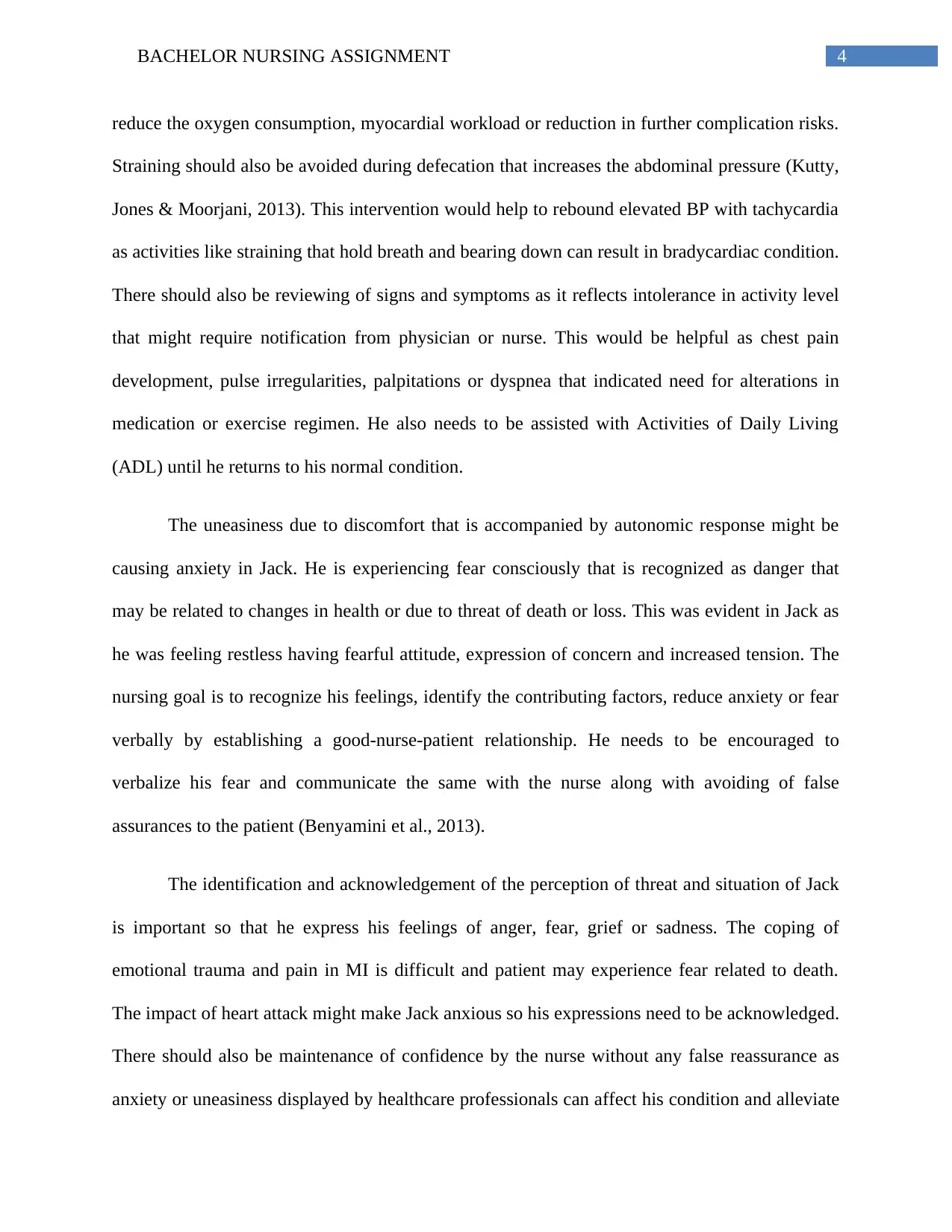
4BACHELOR NURSING ASSIGNMENT
reduce the oxygen consumption, myocardial workload or reduction in further complication risks.
Straining should also be avoided during defecation that increases the abdominal pressure (Kutty,
Jones & Moorjani, 2013). This intervention would help to rebound elevated BP with tachycardia
as activities like straining that hold breath and bearing down can result in bradycardiac condition.
There should also be reviewing of signs and symptoms as it reflects intolerance in activity level
that might require notification from physician or nurse. This would be helpful as chest pain
development, pulse irregularities, palpitations or dyspnea that indicated need for alterations in
medication or exercise regimen. He also needs to be assisted with Activities of Daily Living
(ADL) until he returns to his normal condition.
The uneasiness due to discomfort that is accompanied by autonomic response might be
causing anxiety in Jack. He is experiencing fear consciously that is recognized as danger that
may be related to changes in health or due to threat of death or loss. This was evident in Jack as
he was feeling restless having fearful attitude, expression of concern and increased tension. The
nursing goal is to recognize his feelings, identify the contributing factors, reduce anxiety or fear
verbally by establishing a good-nurse-patient relationship. He needs to be encouraged to
verbalize his fear and communicate the same with the nurse along with avoiding of false
assurances to the patient (Benyamini et al., 2013).
The identification and acknowledgement of the perception of threat and situation of Jack
is important so that he express his feelings of anger, fear, grief or sadness. The coping of
emotional trauma and pain in MI is difficult and patient may experience fear related to death.
The impact of heart attack might make Jack anxious so his expressions need to be acknowledged.
There should also be maintenance of confidence by the nurse without any false reassurance as
anxiety or uneasiness displayed by healthcare professionals can affect his condition and alleviate
reduce the oxygen consumption, myocardial workload or reduction in further complication risks.
Straining should also be avoided during defecation that increases the abdominal pressure (Kutty,
Jones & Moorjani, 2013). This intervention would help to rebound elevated BP with tachycardia
as activities like straining that hold breath and bearing down can result in bradycardiac condition.
There should also be reviewing of signs and symptoms as it reflects intolerance in activity level
that might require notification from physician or nurse. This would be helpful as chest pain
development, pulse irregularities, palpitations or dyspnea that indicated need for alterations in
medication or exercise regimen. He also needs to be assisted with Activities of Daily Living
(ADL) until he returns to his normal condition.
The uneasiness due to discomfort that is accompanied by autonomic response might be
causing anxiety in Jack. He is experiencing fear consciously that is recognized as danger that
may be related to changes in health or due to threat of death or loss. This was evident in Jack as
he was feeling restless having fearful attitude, expression of concern and increased tension. The
nursing goal is to recognize his feelings, identify the contributing factors, reduce anxiety or fear
verbally by establishing a good-nurse-patient relationship. He needs to be encouraged to
verbalize his fear and communicate the same with the nurse along with avoiding of false
assurances to the patient (Benyamini et al., 2013).
The identification and acknowledgement of the perception of threat and situation of Jack
is important so that he express his feelings of anger, fear, grief or sadness. The coping of
emotional trauma and pain in MI is difficult and patient may experience fear related to death.
The impact of heart attack might make Jack anxious so his expressions need to be acknowledged.
There should also be maintenance of confidence by the nurse without any false reassurance as
anxiety or uneasiness displayed by healthcare professionals can affect his condition and alleviate
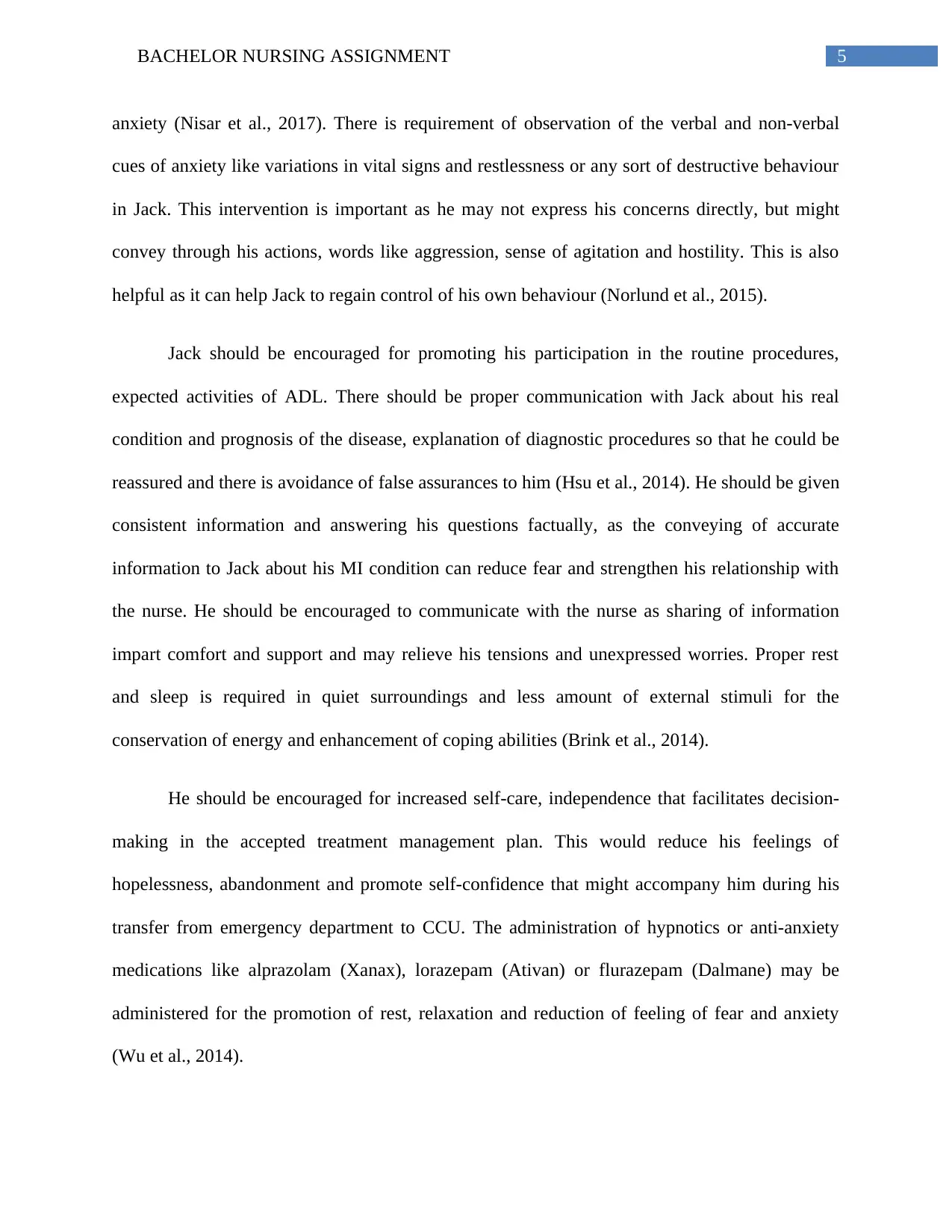
5BACHELOR NURSING ASSIGNMENT
anxiety (Nisar et al., 2017). There is requirement of observation of the verbal and non-verbal
cues of anxiety like variations in vital signs and restlessness or any sort of destructive behaviour
in Jack. This intervention is important as he may not express his concerns directly, but might
convey through his actions, words like aggression, sense of agitation and hostility. This is also
helpful as it can help Jack to regain control of his own behaviour (Norlund et al., 2015).
Jack should be encouraged for promoting his participation in the routine procedures,
expected activities of ADL. There should be proper communication with Jack about his real
condition and prognosis of the disease, explanation of diagnostic procedures so that he could be
reassured and there is avoidance of false assurances to him (Hsu et al., 2014). He should be given
consistent information and answering his questions factually, as the conveying of accurate
information to Jack about his MI condition can reduce fear and strengthen his relationship with
the nurse. He should be encouraged to communicate with the nurse as sharing of information
impart comfort and support and may relieve his tensions and unexpressed worries. Proper rest
and sleep is required in quiet surroundings and less amount of external stimuli for the
conservation of energy and enhancement of coping abilities (Brink et al., 2014).
He should be encouraged for increased self-care, independence that facilitates decision-
making in the accepted treatment management plan. This would reduce his feelings of
hopelessness, abandonment and promote self-confidence that might accompany him during his
transfer from emergency department to CCU. The administration of hypnotics or anti-anxiety
medications like alprazolam (Xanax), lorazepam (Ativan) or flurazepam (Dalmane) may be
administered for the promotion of rest, relaxation and reduction of feeling of fear and anxiety
(Wu et al., 2014).
anxiety (Nisar et al., 2017). There is requirement of observation of the verbal and non-verbal
cues of anxiety like variations in vital signs and restlessness or any sort of destructive behaviour
in Jack. This intervention is important as he may not express his concerns directly, but might
convey through his actions, words like aggression, sense of agitation and hostility. This is also
helpful as it can help Jack to regain control of his own behaviour (Norlund et al., 2015).
Jack should be encouraged for promoting his participation in the routine procedures,
expected activities of ADL. There should be proper communication with Jack about his real
condition and prognosis of the disease, explanation of diagnostic procedures so that he could be
reassured and there is avoidance of false assurances to him (Hsu et al., 2014). He should be given
consistent information and answering his questions factually, as the conveying of accurate
information to Jack about his MI condition can reduce fear and strengthen his relationship with
the nurse. He should be encouraged to communicate with the nurse as sharing of information
impart comfort and support and may relieve his tensions and unexpressed worries. Proper rest
and sleep is required in quiet surroundings and less amount of external stimuli for the
conservation of energy and enhancement of coping abilities (Brink et al., 2014).
He should be encouraged for increased self-care, independence that facilitates decision-
making in the accepted treatment management plan. This would reduce his feelings of
hopelessness, abandonment and promote self-confidence that might accompany him during his
transfer from emergency department to CCU. The administration of hypnotics or anti-anxiety
medications like alprazolam (Xanax), lorazepam (Ativan) or flurazepam (Dalmane) may be
administered for the promotion of rest, relaxation and reduction of feeling of fear and anxiety
(Wu et al., 2014).
⊘ This is a preview!⊘
Do you want full access?
Subscribe today to unlock all pages.

Trusted by 1+ million students worldwide
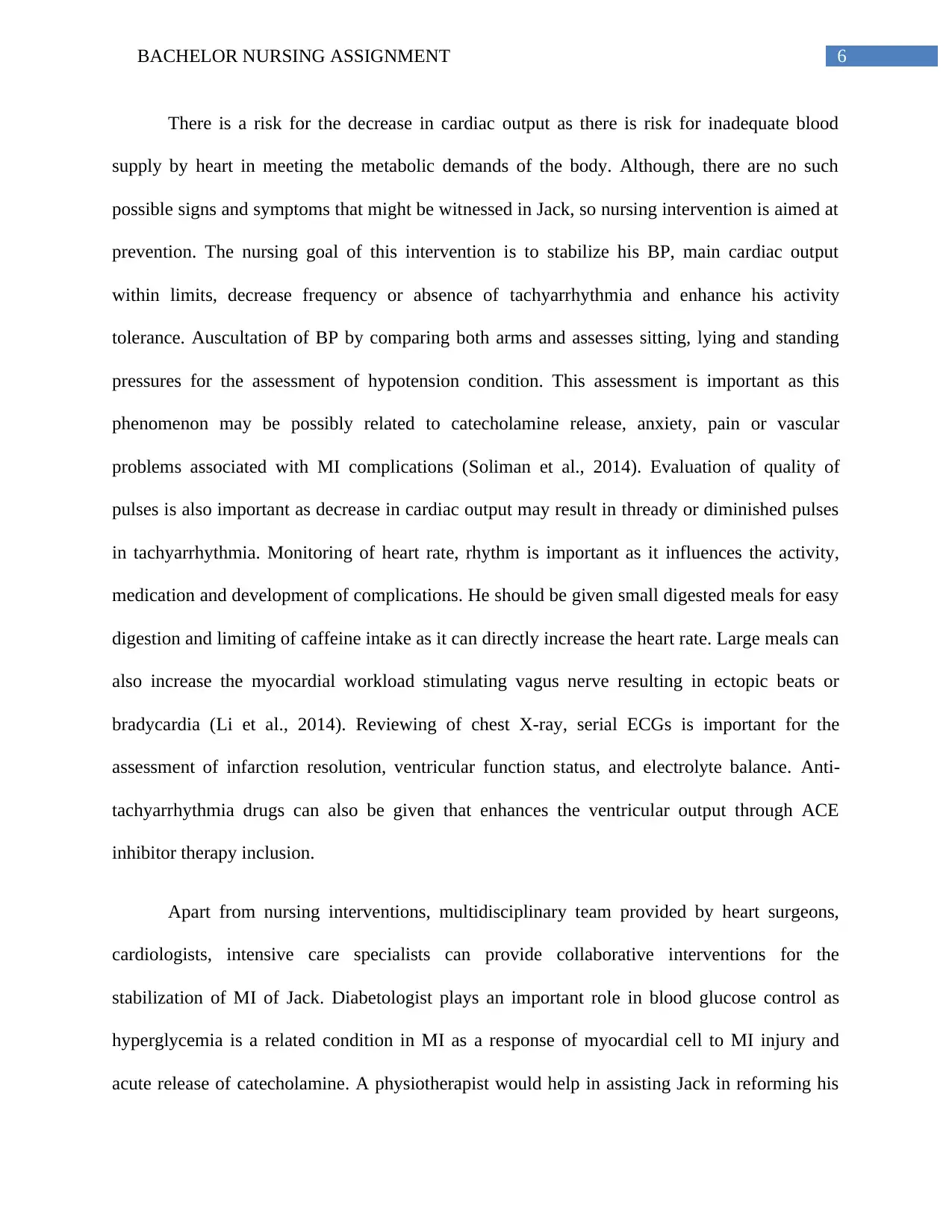
6BACHELOR NURSING ASSIGNMENT
There is a risk for the decrease in cardiac output as there is risk for inadequate blood
supply by heart in meeting the metabolic demands of the body. Although, there are no such
possible signs and symptoms that might be witnessed in Jack, so nursing intervention is aimed at
prevention. The nursing goal of this intervention is to stabilize his BP, main cardiac output
within limits, decrease frequency or absence of tachyarrhythmia and enhance his activity
tolerance. Auscultation of BP by comparing both arms and assesses sitting, lying and standing
pressures for the assessment of hypotension condition. This assessment is important as this
phenomenon may be possibly related to catecholamine release, anxiety, pain or vascular
problems associated with MI complications (Soliman et al., 2014). Evaluation of quality of
pulses is also important as decrease in cardiac output may result in thready or diminished pulses
in tachyarrhythmia. Monitoring of heart rate, rhythm is important as it influences the activity,
medication and development of complications. He should be given small digested meals for easy
digestion and limiting of caffeine intake as it can directly increase the heart rate. Large meals can
also increase the myocardial workload stimulating vagus nerve resulting in ectopic beats or
bradycardia (Li et al., 2014). Reviewing of chest X-ray, serial ECGs is important for the
assessment of infarction resolution, ventricular function status, and electrolyte balance. Anti-
tachyarrhythmia drugs can also be given that enhances the ventricular output through ACE
inhibitor therapy inclusion.
Apart from nursing interventions, multidisciplinary team provided by heart surgeons,
cardiologists, intensive care specialists can provide collaborative interventions for the
stabilization of MI of Jack. Diabetologist plays an important role in blood glucose control as
hyperglycemia is a related condition in MI as a response of myocardial cell to MI injury and
acute release of catecholamine. A physiotherapist would help in assisting Jack in reforming his
There is a risk for the decrease in cardiac output as there is risk for inadequate blood
supply by heart in meeting the metabolic demands of the body. Although, there are no such
possible signs and symptoms that might be witnessed in Jack, so nursing intervention is aimed at
prevention. The nursing goal of this intervention is to stabilize his BP, main cardiac output
within limits, decrease frequency or absence of tachyarrhythmia and enhance his activity
tolerance. Auscultation of BP by comparing both arms and assesses sitting, lying and standing
pressures for the assessment of hypotension condition. This assessment is important as this
phenomenon may be possibly related to catecholamine release, anxiety, pain or vascular
problems associated with MI complications (Soliman et al., 2014). Evaluation of quality of
pulses is also important as decrease in cardiac output may result in thready or diminished pulses
in tachyarrhythmia. Monitoring of heart rate, rhythm is important as it influences the activity,
medication and development of complications. He should be given small digested meals for easy
digestion and limiting of caffeine intake as it can directly increase the heart rate. Large meals can
also increase the myocardial workload stimulating vagus nerve resulting in ectopic beats or
bradycardia (Li et al., 2014). Reviewing of chest X-ray, serial ECGs is important for the
assessment of infarction resolution, ventricular function status, and electrolyte balance. Anti-
tachyarrhythmia drugs can also be given that enhances the ventricular output through ACE
inhibitor therapy inclusion.
Apart from nursing interventions, multidisciplinary team provided by heart surgeons,
cardiologists, intensive care specialists can provide collaborative interventions for the
stabilization of MI of Jack. Diabetologist plays an important role in blood glucose control as
hyperglycemia is a related condition in MI as a response of myocardial cell to MI injury and
acute release of catecholamine. A physiotherapist would help in assisting Jack in reforming his
Paraphrase This Document
Need a fresh take? Get an instant paraphrase of this document with our AI Paraphraser
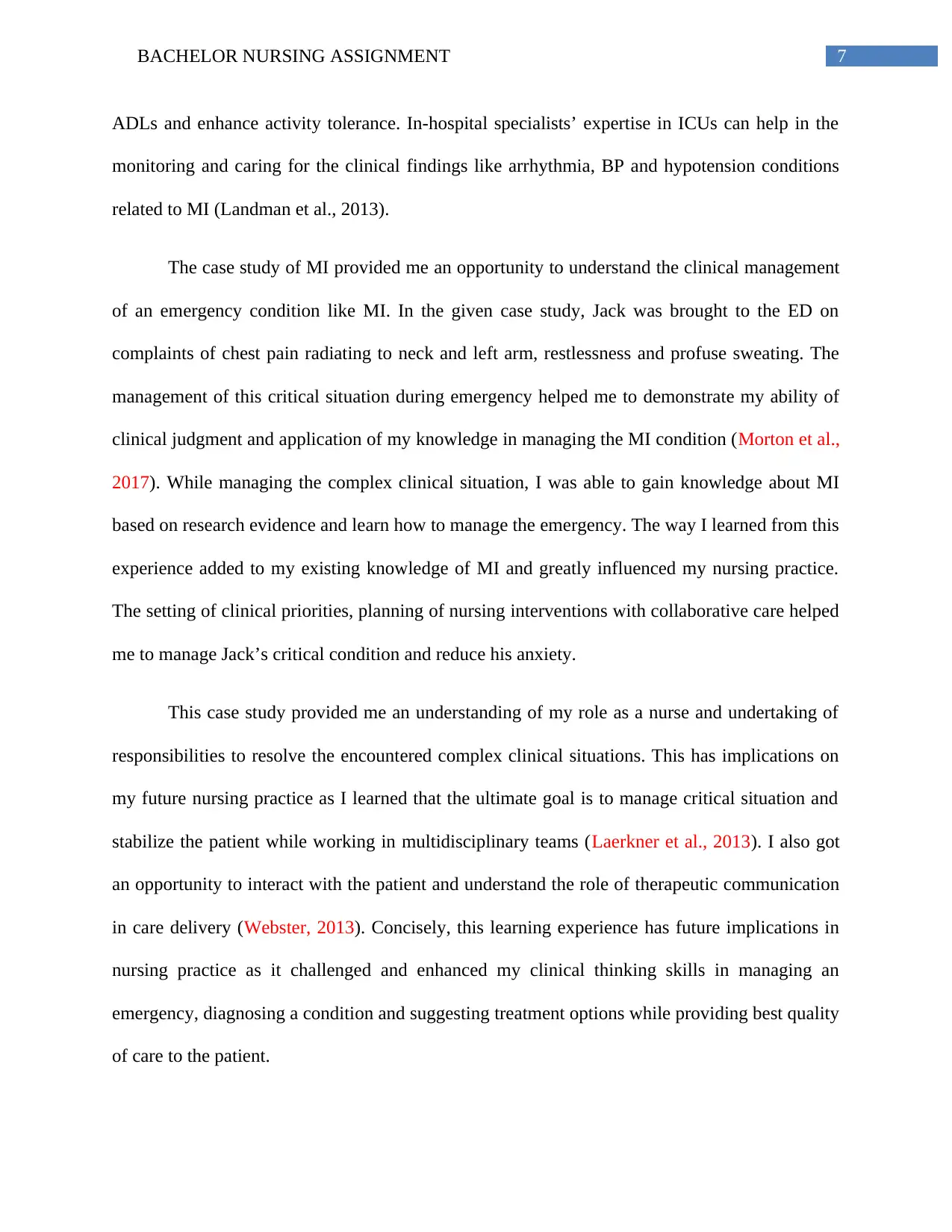
7BACHELOR NURSING ASSIGNMENT
ADLs and enhance activity tolerance. In-hospital specialists’ expertise in ICUs can help in the
monitoring and caring for the clinical findings like arrhythmia, BP and hypotension conditions
related to MI (Landman et al., 2013).
The case study of MI provided me an opportunity to understand the clinical management
of an emergency condition like MI. In the given case study, Jack was brought to the ED on
complaints of chest pain radiating to neck and left arm, restlessness and profuse sweating. The
management of this critical situation during emergency helped me to demonstrate my ability of
clinical judgment and application of my knowledge in managing the MI condition (Morton et al.,
2017). While managing the complex clinical situation, I was able to gain knowledge about MI
based on research evidence and learn how to manage the emergency. The way I learned from this
experience added to my existing knowledge of MI and greatly influenced my nursing practice.
The setting of clinical priorities, planning of nursing interventions with collaborative care helped
me to manage Jack’s critical condition and reduce his anxiety.
This case study provided me an understanding of my role as a nurse and undertaking of
responsibilities to resolve the encountered complex clinical situations. This has implications on
my future nursing practice as I learned that the ultimate goal is to manage critical situation and
stabilize the patient while working in multidisciplinary teams (Laerkner et al., 2013). I also got
an opportunity to interact with the patient and understand the role of therapeutic communication
in care delivery (Webster, 2013). Concisely, this learning experience has future implications in
nursing practice as it challenged and enhanced my clinical thinking skills in managing an
emergency, diagnosing a condition and suggesting treatment options while providing best quality
of care to the patient.
ADLs and enhance activity tolerance. In-hospital specialists’ expertise in ICUs can help in the
monitoring and caring for the clinical findings like arrhythmia, BP and hypotension conditions
related to MI (Landman et al., 2013).
The case study of MI provided me an opportunity to understand the clinical management
of an emergency condition like MI. In the given case study, Jack was brought to the ED on
complaints of chest pain radiating to neck and left arm, restlessness and profuse sweating. The
management of this critical situation during emergency helped me to demonstrate my ability of
clinical judgment and application of my knowledge in managing the MI condition (Morton et al.,
2017). While managing the complex clinical situation, I was able to gain knowledge about MI
based on research evidence and learn how to manage the emergency. The way I learned from this
experience added to my existing knowledge of MI and greatly influenced my nursing practice.
The setting of clinical priorities, planning of nursing interventions with collaborative care helped
me to manage Jack’s critical condition and reduce his anxiety.
This case study provided me an understanding of my role as a nurse and undertaking of
responsibilities to resolve the encountered complex clinical situations. This has implications on
my future nursing practice as I learned that the ultimate goal is to manage critical situation and
stabilize the patient while working in multidisciplinary teams (Laerkner et al., 2013). I also got
an opportunity to interact with the patient and understand the role of therapeutic communication
in care delivery (Webster, 2013). Concisely, this learning experience has future implications in
nursing practice as it challenged and enhanced my clinical thinking skills in managing an
emergency, diagnosing a condition and suggesting treatment options while providing best quality
of care to the patient.

8BACHELOR NURSING ASSIGNMENT
⊘ This is a preview!⊘
Do you want full access?
Subscribe today to unlock all pages.

Trusted by 1+ million students worldwide
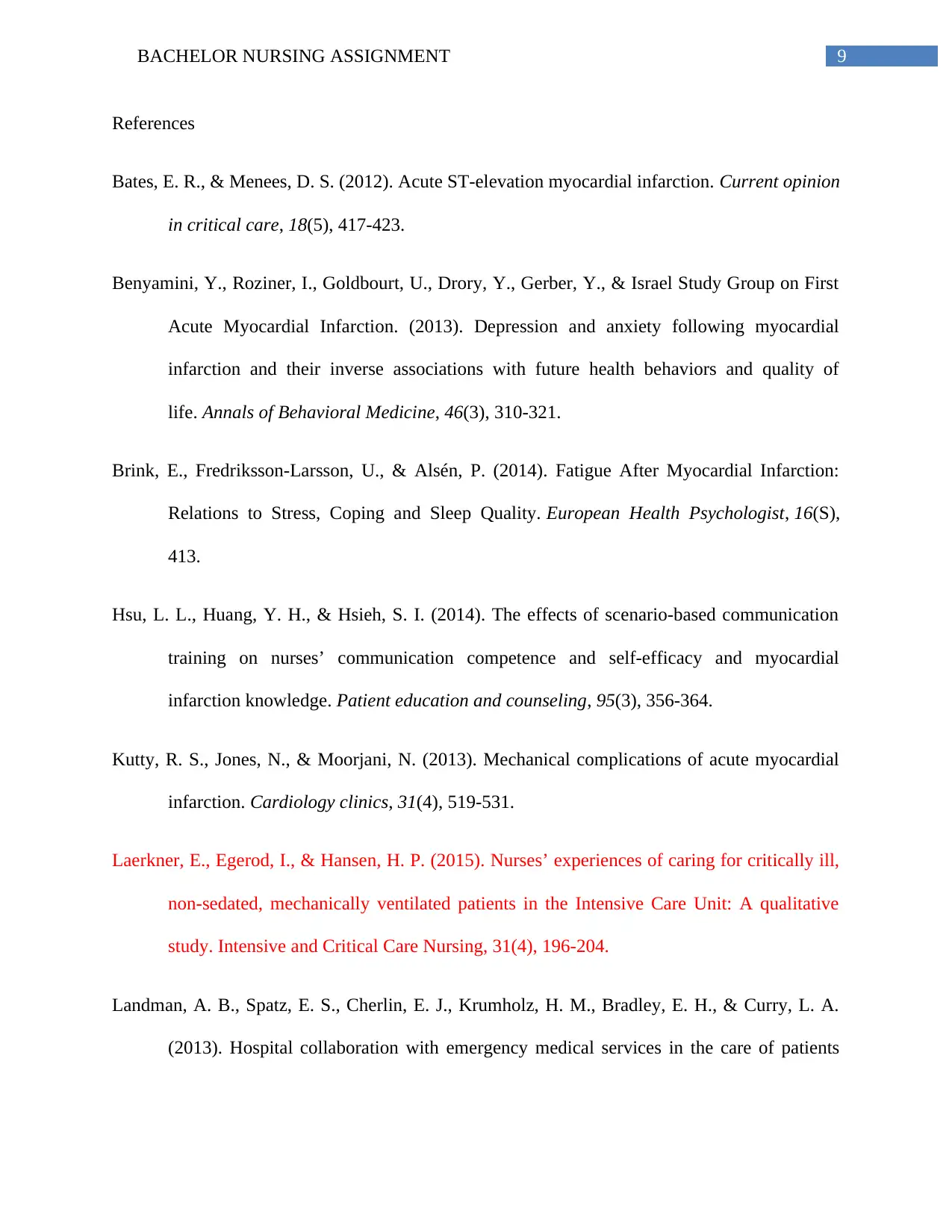
9BACHELOR NURSING ASSIGNMENT
References
Bates, E. R., & Menees, D. S. (2012). Acute ST-elevation myocardial infarction. Current opinion
in critical care, 18(5), 417-423.
Benyamini, Y., Roziner, I., Goldbourt, U., Drory, Y., Gerber, Y., & Israel Study Group on First
Acute Myocardial Infarction. (2013). Depression and anxiety following myocardial
infarction and their inverse associations with future health behaviors and quality of
life. Annals of Behavioral Medicine, 46(3), 310-321.
Brink, E., Fredriksson-Larsson, U., & Alsén, P. (2014). Fatigue After Myocardial Infarction:
Relations to Stress, Coping and Sleep Quality. European Health Psychologist, 16(S),
413.
Hsu, L. L., Huang, Y. H., & Hsieh, S. I. (2014). The effects of scenario-based communication
training on nurses’ communication competence and self-efficacy and myocardial
infarction knowledge. Patient education and counseling, 95(3), 356-364.
Kutty, R. S., Jones, N., & Moorjani, N. (2013). Mechanical complications of acute myocardial
infarction. Cardiology clinics, 31(4), 519-531.
Laerkner, E., Egerod, I., & Hansen, H. P. (2015). Nurses’ experiences of caring for critically ill,
non-sedated, mechanically ventilated patients in the Intensive Care Unit: A qualitative
study. Intensive and Critical Care Nursing, 31(4), 196-204.
Landman, A. B., Spatz, E. S., Cherlin, E. J., Krumholz, H. M., Bradley, E. H., & Curry, L. A.
(2013). Hospital collaboration with emergency medical services in the care of patients
References
Bates, E. R., & Menees, D. S. (2012). Acute ST-elevation myocardial infarction. Current opinion
in critical care, 18(5), 417-423.
Benyamini, Y., Roziner, I., Goldbourt, U., Drory, Y., Gerber, Y., & Israel Study Group on First
Acute Myocardial Infarction. (2013). Depression and anxiety following myocardial
infarction and their inverse associations with future health behaviors and quality of
life. Annals of Behavioral Medicine, 46(3), 310-321.
Brink, E., Fredriksson-Larsson, U., & Alsén, P. (2014). Fatigue After Myocardial Infarction:
Relations to Stress, Coping and Sleep Quality. European Health Psychologist, 16(S),
413.
Hsu, L. L., Huang, Y. H., & Hsieh, S. I. (2014). The effects of scenario-based communication
training on nurses’ communication competence and self-efficacy and myocardial
infarction knowledge. Patient education and counseling, 95(3), 356-364.
Kutty, R. S., Jones, N., & Moorjani, N. (2013). Mechanical complications of acute myocardial
infarction. Cardiology clinics, 31(4), 519-531.
Laerkner, E., Egerod, I., & Hansen, H. P. (2015). Nurses’ experiences of caring for critically ill,
non-sedated, mechanically ventilated patients in the Intensive Care Unit: A qualitative
study. Intensive and Critical Care Nursing, 31(4), 196-204.
Landman, A. B., Spatz, E. S., Cherlin, E. J., Krumholz, H. M., Bradley, E. H., & Curry, L. A.
(2013). Hospital collaboration with emergency medical services in the care of patients
Paraphrase This Document
Need a fresh take? Get an instant paraphrase of this document with our AI Paraphraser
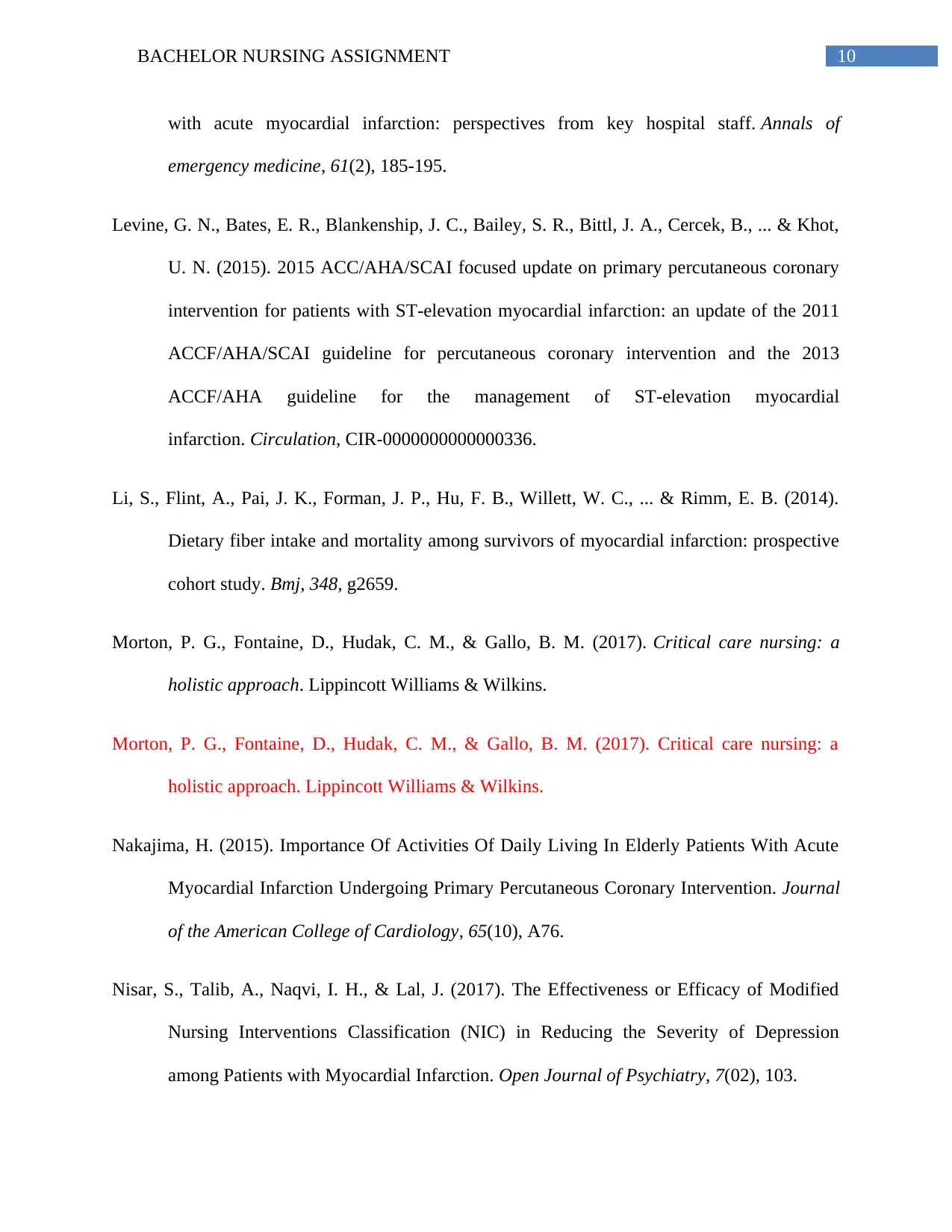
10BACHELOR NURSING ASSIGNMENT
with acute myocardial infarction: perspectives from key hospital staff. Annals of
emergency medicine, 61(2), 185-195.
Levine, G. N., Bates, E. R., Blankenship, J. C., Bailey, S. R., Bittl, J. A., Cercek, B., ... & Khot,
U. N. (2015). 2015 ACC/AHA/SCAI focused update on primary percutaneous coronary
intervention for patients with ST-elevation myocardial infarction: an update of the 2011
ACCF/AHA/SCAI guideline for percutaneous coronary intervention and the 2013
ACCF/AHA guideline for the management of ST-elevation myocardial
infarction. Circulation, CIR-0000000000000336.
Li, S., Flint, A., Pai, J. K., Forman, J. P., Hu, F. B., Willett, W. C., ... & Rimm, E. B. (2014).
Dietary fiber intake and mortality among survivors of myocardial infarction: prospective
cohort study. Bmj, 348, g2659.
Morton, P. G., Fontaine, D., Hudak, C. M., & Gallo, B. M. (2017). Critical care nursing: a
holistic approach. Lippincott Williams & Wilkins.
Morton, P. G., Fontaine, D., Hudak, C. M., & Gallo, B. M. (2017). Critical care nursing: a
holistic approach. Lippincott Williams & Wilkins.
Nakajima, H. (2015). Importance Of Activities Of Daily Living In Elderly Patients With Acute
Myocardial Infarction Undergoing Primary Percutaneous Coronary Intervention. Journal
of the American College of Cardiology, 65(10), A76.
Nisar, S., Talib, A., Naqvi, I. H., & Lal, J. (2017). The Effectiveness or Efficacy of Modified
Nursing Interventions Classification (NIC) in Reducing the Severity of Depression
among Patients with Myocardial Infarction. Open Journal of Psychiatry, 7(02), 103.
with acute myocardial infarction: perspectives from key hospital staff. Annals of
emergency medicine, 61(2), 185-195.
Levine, G. N., Bates, E. R., Blankenship, J. C., Bailey, S. R., Bittl, J. A., Cercek, B., ... & Khot,
U. N. (2015). 2015 ACC/AHA/SCAI focused update on primary percutaneous coronary
intervention for patients with ST-elevation myocardial infarction: an update of the 2011
ACCF/AHA/SCAI guideline for percutaneous coronary intervention and the 2013
ACCF/AHA guideline for the management of ST-elevation myocardial
infarction. Circulation, CIR-0000000000000336.
Li, S., Flint, A., Pai, J. K., Forman, J. P., Hu, F. B., Willett, W. C., ... & Rimm, E. B. (2014).
Dietary fiber intake and mortality among survivors of myocardial infarction: prospective
cohort study. Bmj, 348, g2659.
Morton, P. G., Fontaine, D., Hudak, C. M., & Gallo, B. M. (2017). Critical care nursing: a
holistic approach. Lippincott Williams & Wilkins.
Morton, P. G., Fontaine, D., Hudak, C. M., & Gallo, B. M. (2017). Critical care nursing: a
holistic approach. Lippincott Williams & Wilkins.
Nakajima, H. (2015). Importance Of Activities Of Daily Living In Elderly Patients With Acute
Myocardial Infarction Undergoing Primary Percutaneous Coronary Intervention. Journal
of the American College of Cardiology, 65(10), A76.
Nisar, S., Talib, A., Naqvi, I. H., & Lal, J. (2017). The Effectiveness or Efficacy of Modified
Nursing Interventions Classification (NIC) in Reducing the Severity of Depression
among Patients with Myocardial Infarction. Open Journal of Psychiatry, 7(02), 103.
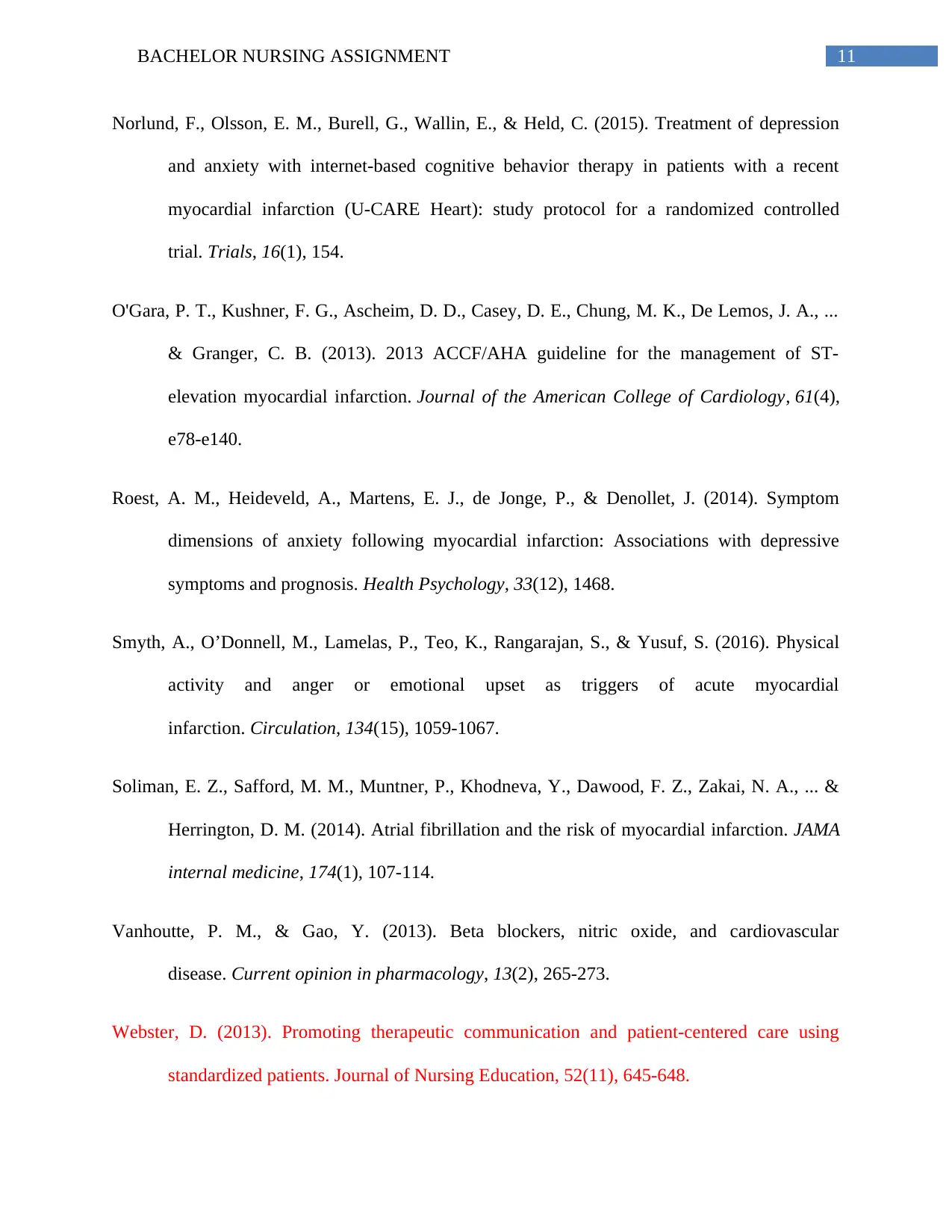
11BACHELOR NURSING ASSIGNMENT
Norlund, F., Olsson, E. M., Burell, G., Wallin, E., & Held, C. (2015). Treatment of depression
and anxiety with internet-based cognitive behavior therapy in patients with a recent
myocardial infarction (U-CARE Heart): study protocol for a randomized controlled
trial. Trials, 16(1), 154.
O'Gara, P. T., Kushner, F. G., Ascheim, D. D., Casey, D. E., Chung, M. K., De Lemos, J. A., ...
& Granger, C. B. (2013). 2013 ACCF/AHA guideline for the management of ST-
elevation myocardial infarction. Journal of the American College of Cardiology, 61(4),
e78-e140.
Roest, A. M., Heideveld, A., Martens, E. J., de Jonge, P., & Denollet, J. (2014). Symptom
dimensions of anxiety following myocardial infarction: Associations with depressive
symptoms and prognosis. Health Psychology, 33(12), 1468.
Smyth, A., O’Donnell, M., Lamelas, P., Teo, K., Rangarajan, S., & Yusuf, S. (2016). Physical
activity and anger or emotional upset as triggers of acute myocardial
infarction. Circulation, 134(15), 1059-1067.
Soliman, E. Z., Safford, M. M., Muntner, P., Khodneva, Y., Dawood, F. Z., Zakai, N. A., ... &
Herrington, D. M. (2014). Atrial fibrillation and the risk of myocardial infarction. JAMA
internal medicine, 174(1), 107-114.
Vanhoutte, P. M., & Gao, Y. (2013). Beta blockers, nitric oxide, and cardiovascular
disease. Current opinion in pharmacology, 13(2), 265-273.
Webster, D. (2013). Promoting therapeutic communication and patient-centered care using
standardized patients. Journal of Nursing Education, 52(11), 645-648.
Norlund, F., Olsson, E. M., Burell, G., Wallin, E., & Held, C. (2015). Treatment of depression
and anxiety with internet-based cognitive behavior therapy in patients with a recent
myocardial infarction (U-CARE Heart): study protocol for a randomized controlled
trial. Trials, 16(1), 154.
O'Gara, P. T., Kushner, F. G., Ascheim, D. D., Casey, D. E., Chung, M. K., De Lemos, J. A., ...
& Granger, C. B. (2013). 2013 ACCF/AHA guideline for the management of ST-
elevation myocardial infarction. Journal of the American College of Cardiology, 61(4),
e78-e140.
Roest, A. M., Heideveld, A., Martens, E. J., de Jonge, P., & Denollet, J. (2014). Symptom
dimensions of anxiety following myocardial infarction: Associations with depressive
symptoms and prognosis. Health Psychology, 33(12), 1468.
Smyth, A., O’Donnell, M., Lamelas, P., Teo, K., Rangarajan, S., & Yusuf, S. (2016). Physical
activity and anger or emotional upset as triggers of acute myocardial
infarction. Circulation, 134(15), 1059-1067.
Soliman, E. Z., Safford, M. M., Muntner, P., Khodneva, Y., Dawood, F. Z., Zakai, N. A., ... &
Herrington, D. M. (2014). Atrial fibrillation and the risk of myocardial infarction. JAMA
internal medicine, 174(1), 107-114.
Vanhoutte, P. M., & Gao, Y. (2013). Beta blockers, nitric oxide, and cardiovascular
disease. Current opinion in pharmacology, 13(2), 265-273.
Webster, D. (2013). Promoting therapeutic communication and patient-centered care using
standardized patients. Journal of Nursing Education, 52(11), 645-648.
⊘ This is a preview!⊘
Do you want full access?
Subscribe today to unlock all pages.

Trusted by 1+ million students worldwide
1 out of 13
Related Documents
Your All-in-One AI-Powered Toolkit for Academic Success.
+13062052269
info@desklib.com
Available 24*7 on WhatsApp / Email
![[object Object]](/_next/static/media/star-bottom.7253800d.svg)
Unlock your academic potential
Copyright © 2020–2025 A2Z Services. All Rights Reserved. Developed and managed by ZUCOL.




